

List-Group-Label. List-Group-Label (Taba, 1967) is a vocabulary strategy where students are asked to generate a list of words, group them according to their similarities, then label the group.
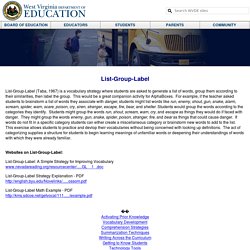
This would be a great companion activity for AlphaBoxes. For example, if the teacher asked students to brainstorm a list of words they associate with danger, students might list words like run, enemy, shout, gun, snake, alarm, scream, spider, warn, scare, poison, cry, siren, stranger, escape, fire, bear, and shelter. Students would group the words according to the categories they identify. English Profile - Text Inspector.
Revised blooms chart. Learning skills. The Art of Learning. Tips for Students Videos for Students Links for Students This page will develop into a collection of all sorts of things - tips, videos, links to great sites - all designed to help you study.

At the moment I have made links to some great websites which will help you with studying all your school subjects, no matter where you are. And if you are stuck with understanding anything at school, don't forget YouTube - a great resource for any subject. Scaffolding in Teaching. Bloom's and ICT tools. Many teachers use Bloom's Taxonomy and Bloom's Revised Taxonomy in developing and structuring their teaching & learning experiences.
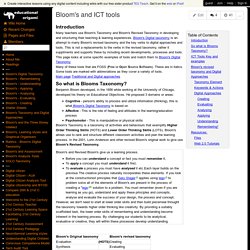
Bloom's Digital taxonomy is an attempt to marry Bloom's revised taxonomy and the key verbs to digital approaches and tools. This is not a replacements to the verbs in the revised taxonomy, rather it suppliments and supports these by including recent developments, processes and tools. This page looks at some specific examples of tools and match them to Bloom's Digital Taxonomy Many of these tools that are FOSS (Free or Open Source Software).
These are in italics. Some tools are marked with abbreviations as they cover a variety of tools.Main pageTraditional and Digital approaches Benjamin Bloom developed, in the 1956 while working at the University of Chicago, developed his theory on Educational Objectives. Files Web 2.0 Tutorials Without a doubt one of the best resources on the web for web2.0 Technologies is the commoncraft show. Scaffolding in Education: Definition, Theory & Examples. Scaffolding Definition. In education, scaffolding refers to a variety of instructional techniques used to move students progressively toward stronger understanding and, ultimately, greater independence in the learning process.
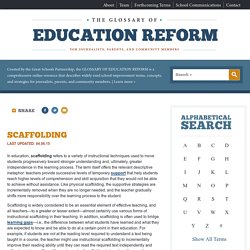
The term itself offers the relevant descriptive metaphor: teachers provide successive levels of temporary support that help students reach higher levels of comprehension and skill acquisition that they would not be able to achieve without assistance. Like physical scaffolding, the supportive strategies are incrementally removed when they are no longer needed, and the teacher gradually shifts more responsibility over the learning process to the student. Scaffolding is widely considered to be an essential element of effective teaching, and all teachers—to a greater or lesser extent—almost certainly use various forms of instructional scaffolding in their teaching. Scaffolding vs. The following examples will serve to illustrate a few common scaffolding strategies: Il mio padlet fantasioso. UDL Guidelines 2.0. The goal of education in the 21st century is not simply the mastery of content knowledge or use of new technologies.
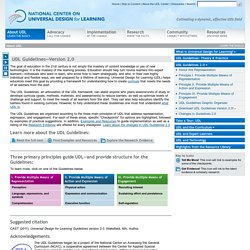
It is the mastery of the learning process. Education should help turn novice learners into expert learners—individuals who want to learn, who know how to learn strategically, and who, in their own highly individual and flexible ways, are well prepared for a lifetime of learning. Universal Design for Learning (UDL) helps educators meet this goal by providing a framework for understanding how to create curricula that meets the needs of all learners from the start. Bloom’s Digital Taxonomy Resources. As part of preparing for a series of presentations at various conferences this year, I have developed six quick sheets for Bloom’s Digital Taxonomy.
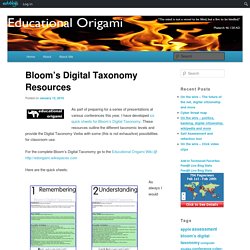
These resources outline the different taxonomic levels and provide the Digital Taxonomy Verbs with some (this is not exhaustive) possibilities for classroom use. For the complete Bloom’s Digital Taxonomy go to the Educational Origami Wiki @ Here are the quick sheets: As always I would appreciate comments, feedback and suggestions. NoelleCombsInquiryLesson. Revised Bloom’s Taxonomy [Flash Version] – CELT. If you have trouble accessing the interactive Flash-based model below, the content is available via: A statement of a learning objective contains a verb (an action) and an object (usually a noun).
![Revised Bloom’s Taxonomy [Flash Version] – CELT](http://cdn.pearltrees.com/s/pic/th/revised-bloom-taxonomy-version-144971013)
The verb generally refers to [actions associated with] the intended cognitive process.The object generally describes the knowledge students are expected to acquire or construct. (Anderson and Krathwohl, 2001, pp. 4–5) The cognitive process dimension represents a continuum of increasing cognitive complexity—from remember to create. Revised Bloom’s Taxonomy – CELT.
Jump to the Bloom's Revised Taxonomy Model Go to the Flash version of the Bloom's Revised Taxonomy Model Download the PDF Version.
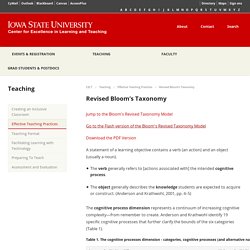
The Best Resources For Helping Teachers Use Bloom’s Taxonomy In The Classroom. Bloom’s & SOLO ‘are not Just Colorful Posters we Hang on the Wall’ is my two-part series at Education Week Teacher.

Bloom’s Taxonomy is talked about a lot in educational circles. However, if you believe a recent survey of visits to 23,000 U.S. classrooms, the higher-order thinking skills it’s ideally designed to promote doesn’t get much use. Speaking frames / Oral language / ESOL teaching strategies / Pedagogy. Bloom's Taxonomy Knowledge Level. A picture is worth a thousand thoughts.
Five of the best CLIL resources online - CLIL Media. In the posts on this website I usually share my opinion on CLIL as well as share some ideas of others.

This time however, I would like to share CLIL resources that I think are really worth your time and can be used to advance both your knowledge of CLIL as well as help you with ideas for your lessons. 1. Peter Sansom’s Blog Peter Sansom is a Dutch Art and Design CLIL teacher who shares his lesson ideas on his blog. His regular updates and easy to read articles are a must read for every art teacher who uses CLIL. 2. CLIL and Drama, a perfect combination according to this website. Do you teach drama? Network 1 CLIL Lessons. CLIL: A lesson framework. Underlying principlesClassroom principlesLesson frameworkConclusion Underlying principlesThe principles behind Content and Language Integrated Learning include global statements such as 'all teachers are teachers of language' (The Bullock Report - A Language for Life, 1975) to the wide-ranging advantages of cross-curricular bilingual teaching in statements from the Content and Language Integrated Project (CLIP).